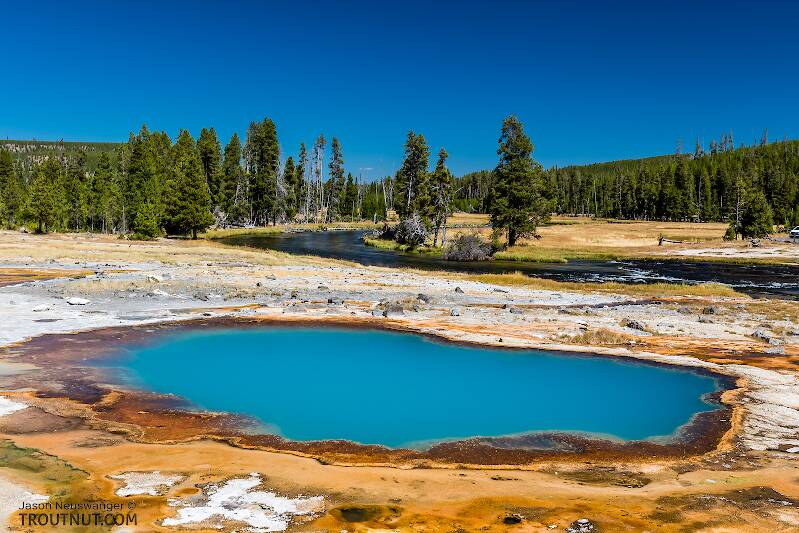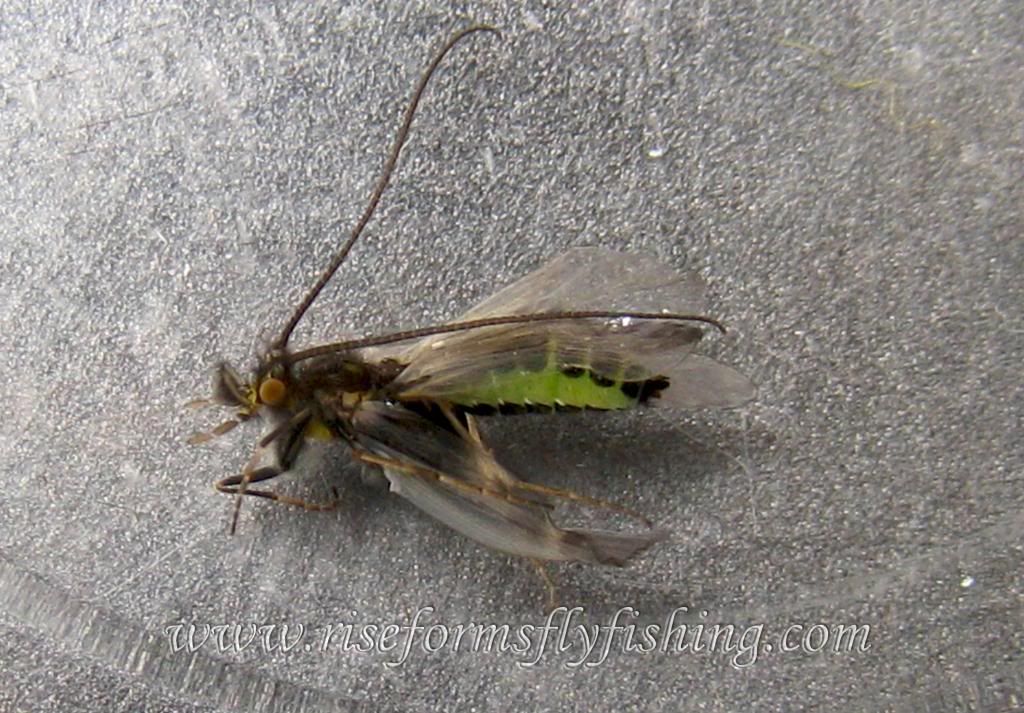
Hex Mayflies
Hexagenia limbata
The famous nocturnal Hex hatch of the Midwest (and a few other lucky locations) stirs to the surface mythically large brown trout that only touch streamers for the rest of the year.
Featured on the forum

This is an interesting one. Following the keys in Merritt R.W., Cummins, K.W., and Berg, M.B. (2019) and Jacobus et al. (2014), it keys clearly to Ephemerella. Jacobus et al provide a key to species, but some of the characteristics are tricky to interpret without illustrations. If I didn't make any mistakes, this one keys to Ephemerella mucronata, which has not previously been reported any closer to here than Montana and Alberta. The main character seems to fit well: "Abdominal terga with prominent, paired, subparallel, spiculate ridges." Several illustrations or descriptions of this holarctic species from the US and Europe seem to match, including the body length, tarsal claws and denticles, labial palp, and gill shapes. These sources include including Richard Allen's original description of this species in North America under the now-defunct name E. moffatae in Allen RK (1977) and the figures in this description of the species in Italy.

Troutnut is a project started in 2003 by salmonid ecologist Jason "Troutnut" Neuswanger to help anglers and
fly tyers unabashedly embrace the entomological side of the sport. Learn more about Troutnut or
support the project for an enhanced experience here.
Entoman on Mar 24, 2013March 24th, 2013, 6:52 pm EDT
Wow, you really captured the bright green chroma, Eric. It's a male, and I'm thinking lateralis because of the width of the stripe. Sure shows why pupal designs incorporating a blend of chartreuse and lime green dubbing, fluor. chartreuse rib, and dark primary feathers as shellbacks work so well. I don't know if an undershell is worth the hassle, though.
"It's not that I find fishing so important, it's just that I find all other endeavors of Man equally unimportant... And not nearly as much fun!" Robert Traver, Anatomy of a Fisherman
Crepuscular on Mar 25, 2013March 25th, 2013, 5:39 am EDT
I don't think it's lateralis. My guess is either numerosus or solomoni.
Entoman on Mar 25, 2013March 25th, 2013, 6:49 am EDT
Hmm... I didn't think that solomoni had the lateral stripe. It could be numerosus as the two look pretty much the same, but it's stripe is thinner, isn't it? What size was it and what kind of water did it come from?
"It's not that I find fishing so important, it's just that I find all other endeavors of Man equally unimportant... And not nearly as much fun!" Robert Traver, Anatomy of a Fisherman
Sayfu
Posts: 560
Posts: 560
Sayfu on Mar 25, 2013March 25th, 2013, 6:52 am EDT
Darn! And I just tied up a bunch of Mother's Day Caddis pupa, and went by the books description of a dark gray body. They say can have a tinge of green in it. I've got that Chartreuse rabbit fur mix that I can just black Pantone pen color the back. And that green displayed is the same color that I found some Fall Baetis bodies to be. Craig Mathews identified them as punctiventris, and the female duns having the bright, green bodies. I think they now are all classified as tricaudatus no?
Crepuscular on Mar 25, 2013March 25th, 2013, 7:09 am EDT
Hmm... I didn't think that solomoni had the lateral stripe. It could be lateralis has the two look pretty much the same, but it's stripe is thinner isn't it? What size was it and what kind of water did it come from?
I'm pretty sure solomoni has the stripe, they are very similar to numerosus. I reared these out from sealed cases I collected last week. They just started to emerge. I ran this one through Flint 1984. They are 10mm. the only thing that he uses to differentiate numerosus from solomoni is what he calls a "small but distinct" subapical lobe on the claspers. the claspers in lateralis are rounded at the apex and the macrochaetae on the tenth tergum are absent as well. The cerci don't look right to be lateralis either. But without these photos you would never be able to see all that. ;)

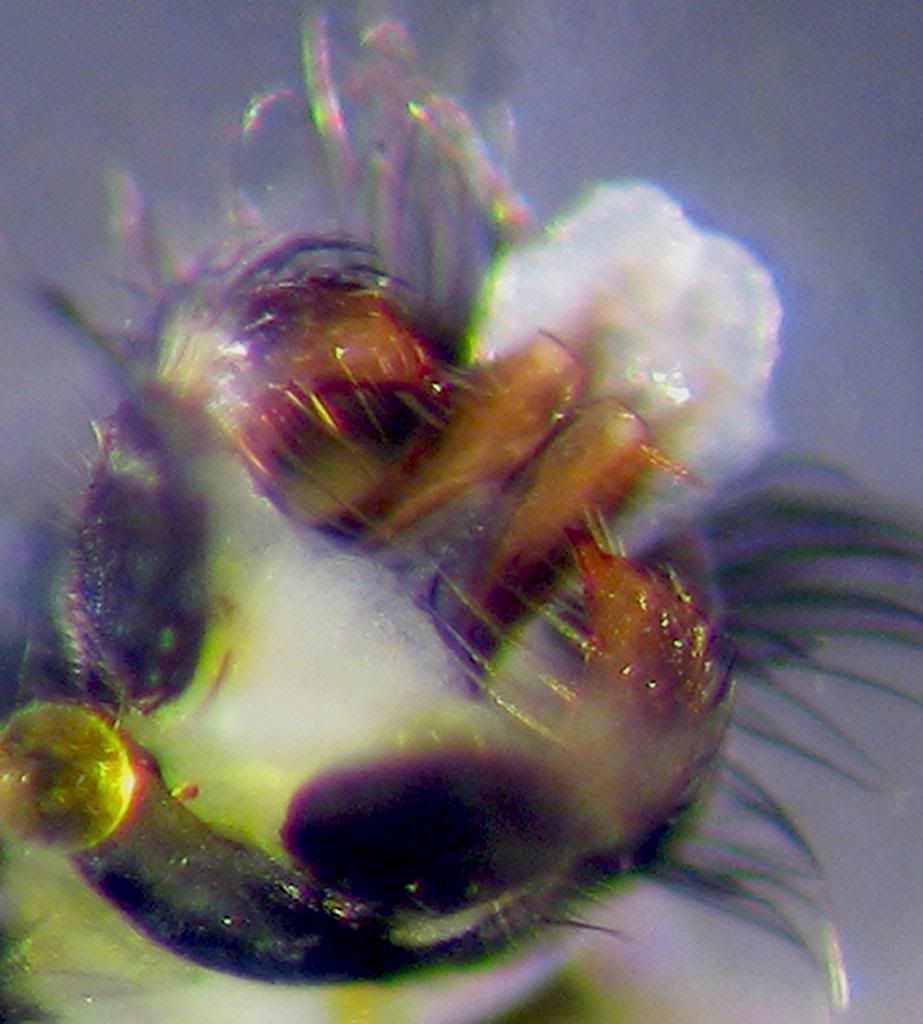
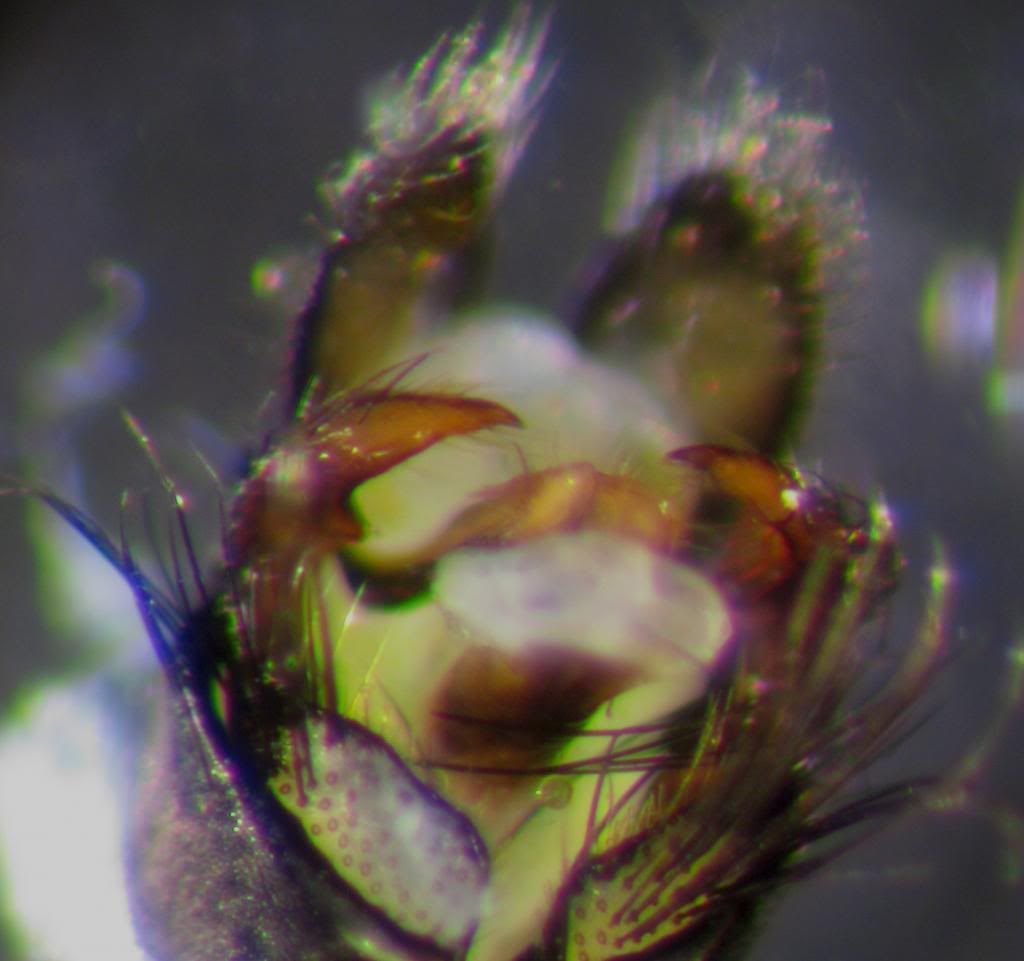
Martinlf on Mar 25, 2013March 25th, 2013, 12:15 pm EDT
Very, very interesting. Old timers in Central PA sometimes use a wet fly with a peacock body for Grannoms. It's effective, but the wrong color it seems. Any thoughts on that?
Sayfu, I'm no expert, but I've been told that the various "olives" that hatch in the fall may come from many different species, and that it's hard to know without detailed photos and close analysis of distinguishing features.
Sayfu, I'm no expert, but I've been told that the various "olives" that hatch in the fall may come from many different species, and that it's hard to know without detailed photos and close analysis of distinguishing features.
"He spread them a yard and a half. 'And every one that got away is this big.'"
--Fred Chappell
--Fred Chappell
Sayfu
Posts: 560
Posts: 560
Sayfu on Mar 25, 2013March 25th, 2013, 2:06 pm EDT
I'm going by what Craig Mathews wrote in his book...Yellowstone Hatches. He identified a female Fall species of Baetis as punctiventrus that had bright green bodies. I fished over them on the SF of the Snake, and got skunked not having any bright green bodied BWO's. Back to the drawing board, and loaded with bright green BWO's I had a number of awesome days. Mathews ID'd them #22-26, and I was able to do well with size #20's.
Martinlf on Mar 25, 2013March 25th, 2013, 5:26 pm EDT
Yes, having local information is always the best. Sounds like you have the right fly, whatever species they are. Tight lines.
"He spread them a yard and a half. 'And every one that got away is this big.'"
--Fred Chappell
--Fred Chappell
Creno on Mar 25, 2013March 25th, 2013, 7:12 pm EDT
Not sure what folks mean by lateral stripe - the abdominal plural area? Pretty good pix of genitalia. I suspect this critter Is Br. solomoni.
Crepuscular on Mar 25, 2013March 25th, 2013, 7:31 pm EDT
Creno, I was hoping you would see this. Yes the ab. pleural area is what everyone refers to as the stripe. I wish I was more familiar with adults (larvae too I suppose). I have no idea how distinct the subapical lobe on the claspers really is. Thanks for your opinion on this one. What do you think about the color? Are these guys brighter than numerosus? I'm referring to the bright green. And I'm assuming they darken after emerging.
Thanks,
Eric
Thanks,
Eric
Gutcutter on Mar 25, 2013March 25th, 2013, 7:39 pm EDT
Sure shows why pupal designs incorporating a blend of chartreuse and lime green dubbing, fluor. chartreuse rib, and dark primary feathers as shellbacks work so well.

Grannom Pupa. Not quite as cool as Kurt's, but works nonetheless.
I don't know if an undershell is worth the hassle, though.
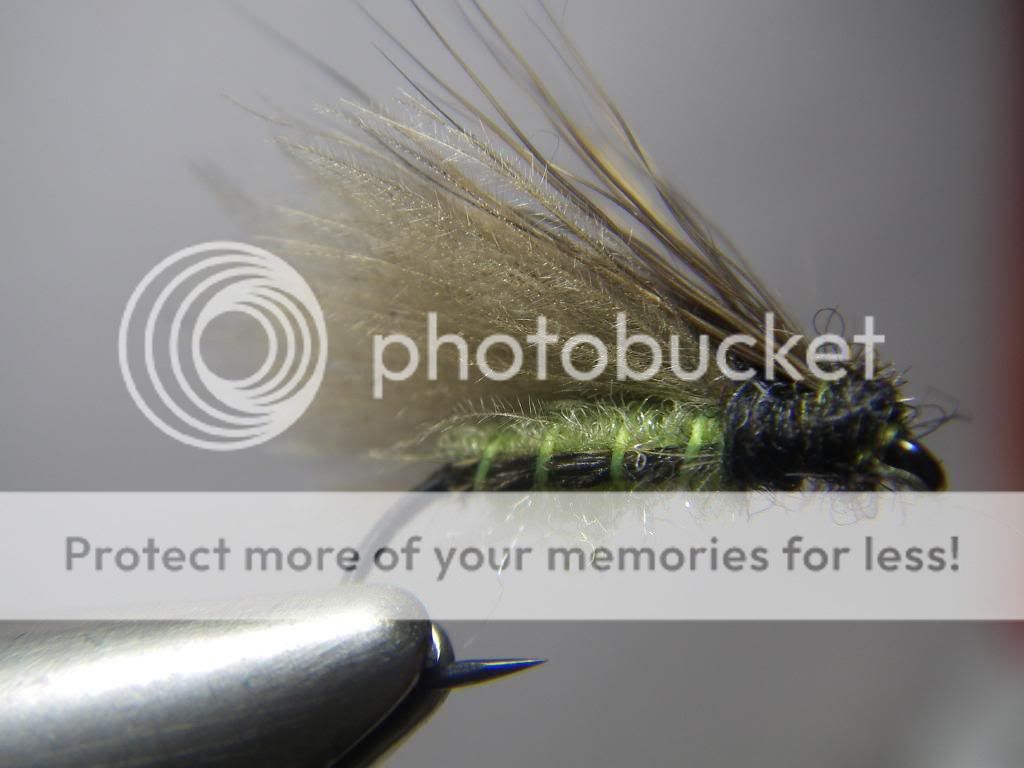
This is an adult with both dorsal and ventral shellbacks. It is a hassle, and I'm not sure that it is worth it, either.
All men who fish may in turn be divided into two parts: those who fish for trout and those who don't. Trout fishermen are a race apart: they are a dedicated crew- indolent, improvident, and quietly mad.
-Robert Traver, Trout Madness
-Robert Traver, Trout Madness
Oldredbarn on Mar 25, 2013March 25th, 2013, 9:39 pm EDT
You are a tier Tony. Sure it's worth it. Nice.
Sayfu. The so-called Mother's Day caddis refers to a western species and I'm not sure it applies to us east of the Mississippi. Check the calendar. :)
Spence
Eric. By the way brother, you are blowing my mind with these pics! It may be time for you to quit your day job. :)
Sayfu. The so-called Mother's Day caddis refers to a western species and I'm not sure it applies to us east of the Mississippi. Check the calendar. :)
Spence
Eric. By the way brother, you are blowing my mind with these pics! It may be time for you to quit your day job. :)
"Even when my best efforts fail it's a satisfying challenge, and that, after all, is the essence of fly fishing." -Chauncy Lively
"Envy not the man who lives beside the river, but the man the river flows through." Joseph T Heywood
"Envy not the man who lives beside the river, but the man the river flows through." Joseph T Heywood
Crepuscular on Mar 26, 2013March 26th, 2013, 3:34 am EDT
You are a tier Tony. Sure it's worth it. Nice.
Spence
Eric. By the way brother, you are blowing my mind with these pics! It may be time for you to quit your day job. :)
I agree with you Spence! Tony those flies are beautiful. I really like the top one.
Quit my day job? Oh you mean something like fake my death and disappear into the Patagonian wilderness or the Indian Ocean somewhere and just take pictures and fish for print and online submission under a new identity?...It never occurred to me.
Sayfu
Posts: 560
Posts: 560
Sayfu on Mar 26, 2013March 26th, 2013, 5:41 am EDT
Oldredbarn, I was thinking that as well. Our Western species is Americanus, and more often occidentalis. And it does show those species to be the same...green, and dark on the back. I should have researched. The adults quickly turn dark with hints of green. I have tied mine up using my softhackle concept, and first incorporate "tentacles" behind the bead head, and then the soft hackle. I rib with a green wire, and then Pantone Pen black on the back. These very small diameter "tenacles" hang back behind the hook bend providing the appearance, and plenty of motion. Can't wait to try them.
Oldredbarn on Mar 26, 2013March 26th, 2013, 7:23 am EDT
Quit my day job? Oh you mean something like fake my death and disappear into the Patagonian wilderness or the Indian Ocean somewhere and just take pictures and fish for print and online submission under a new identity?...It never occurred to me.
Ha! Ha! Yeah something like that...I suspect it would be a healthy trout stream somewhere...Tony & I would be tossing flies, you know who would be hooking cattle, while you would be starring down in to the river...
"Hey you river-rats! Move downstream, damn it! Can't you see I'm working here? You are mucking up the water here..."
Sayfu...I was just saying that I think the western angler coined the term "Mother's Day Caddis"...Those PA boys call it the "Grannom", we Michiganders'...The Little Black Caddis...
Our late guru, Carl Richards finally decided to straighten us out here by explaining that what we thought, for years, was Chimarra was actually Brachycentrus lateralis. The Chimarra is more like a #20-#22...Our old hatch charts had the Little Black Caddis listed at #16-#18...Plus the really little Black Caddis hatches later in the year here than what we had listed...
Most of our fly shops here have very out-dated emergence charts...They still have bugs listed that our scientists tell us no longer exist...Must of gone extinct. ;) One day I'll go looking for a picture I took years ago of a hatch chart that was screwed to the wall in the old cabins I stayed at in Lovell's Michigan...The chart was from the 40-50's and was a hoot.
Some old-timers still call the Hex here, the Michigan Caddis...?!
My fishing partner likes to call me Mr. Lore, when he's not calling me Mr. Hockey. He says, "Lore won't make you a better fisherman!"...But I say, "Modernity simply for modernity's sake is a ruse...Some things are more important than the current fashion and will ultimately endure..." At least as long as I'm around...:)
Spence
"Even when my best efforts fail it's a satisfying challenge, and that, after all, is the essence of fly fishing." -Chauncy Lively
"Envy not the man who lives beside the river, but the man the river flows through." Joseph T Heywood
"Envy not the man who lives beside the river, but the man the river flows through." Joseph T Heywood
Sayfu
Posts: 560
Posts: 560
Sayfu on Mar 26, 2013March 26th, 2013, 7:46 am EDT
Oldredbarn..I just grabbed the word Mother's Day caddis. We call them Black Caddis, Grannoms as well. Actually the species that emerges in the Fall is more likely to be called a Black Caddis.
Entoman on Mar 26, 2013March 26th, 2013, 1:21 pm EDT
Very nice, Tony. It is debatable that mine rank any higher on the "coolness" scale.:)
Jere - Years ago I used to just carry pupa (soft hackles) in olive antron, hare's ear, and PT (like with my elkhairs). I used these for the "big three" (Rhyaco, Hydro, Brachy). This rationale stemmed largely from extrapolating adult colors back to the pupae, which was a mistake. I found my success with pupa near the surface increased dramatically when I incorporated some sort of halo of antron and matched them closer both anatomically as well as by color. Many species have the bright lime green color in their abdomens (especially the Grannoms). Also regarding the brachycentrids, experimenting with an obvious rib vs. not has proven to me that it is an important trigger.
Out West, our notable hatches of brachycentrids are principally made up of the early and dark occidentalis (Mothers Day Caddis) and americanus (Grannom) that is lighter and hatches later, even into the Fall.
Eric - Thanks for the additional photos! Without them, I had to choose between general descriptions provided by various angler sources. I went with Ames (now to my chagrin). In terms of accuracy, another angler entomology bites the dust! Oh well...:)
Jere - Years ago I used to just carry pupa (soft hackles) in olive antron, hare's ear, and PT (like with my elkhairs). I used these for the "big three" (Rhyaco, Hydro, Brachy). This rationale stemmed largely from extrapolating adult colors back to the pupae, which was a mistake. I found my success with pupa near the surface increased dramatically when I incorporated some sort of halo of antron and matched them closer both anatomically as well as by color. Many species have the bright lime green color in their abdomens (especially the Grannoms). Also regarding the brachycentrids, experimenting with an obvious rib vs. not has proven to me that it is an important trigger.
Out West, our notable hatches of brachycentrids are principally made up of the early and dark occidentalis (Mothers Day Caddis) and americanus (Grannom) that is lighter and hatches later, even into the Fall.
Eric - Thanks for the additional photos! Without them, I had to choose between general descriptions provided by various angler sources. I went with Ames (now to my chagrin). In terms of accuracy, another angler entomology bites the dust! Oh well...:)
"It's not that I find fishing so important, it's just that I find all other endeavors of Man equally unimportant... And not nearly as much fun!" Robert Traver, Anatomy of a Fisherman
Sayfu
Posts: 560
Posts: 560
Sayfu on Mar 26, 2013March 26th, 2013, 2:14 pm EDT
Entoman..Thanks for the informative post. If it is the "halo" like Gary L. has encouraged with his patterns, I have not accepted that because of my own personal favor thinking it ruins the profile that I want to present, and has nothing to do with whether it would be more effective, or not. But I have triggers on the brain. I sometimes include the angle hair sparkle with a few strands in the hackle, and sometimes a strand, or two hanging aft of yellow crystal flash, for the emerging air bubble effect.
Entoman on Mar 26, 2013March 26th, 2013, 2:31 pm EDT
If it is the "halo" like Gary L. has encouraged with his patterns...
It isn't. Check out the following photo to see what I'm talking about (you have to scroll down the thread a bit to find it).http://www.troutnut.com/topic/6591/Brachycentrus-Pupal-Behavior
"It's not that I find fishing so important, it's just that I find all other endeavors of Man equally unimportant... And not nearly as much fun!" Robert Traver, Anatomy of a Fisherman
Quick Reply
Related Discussions
Topic
Replies
Last Reply
9
Apr 30, 2013
by Oldredbarn
by Oldredbarn

